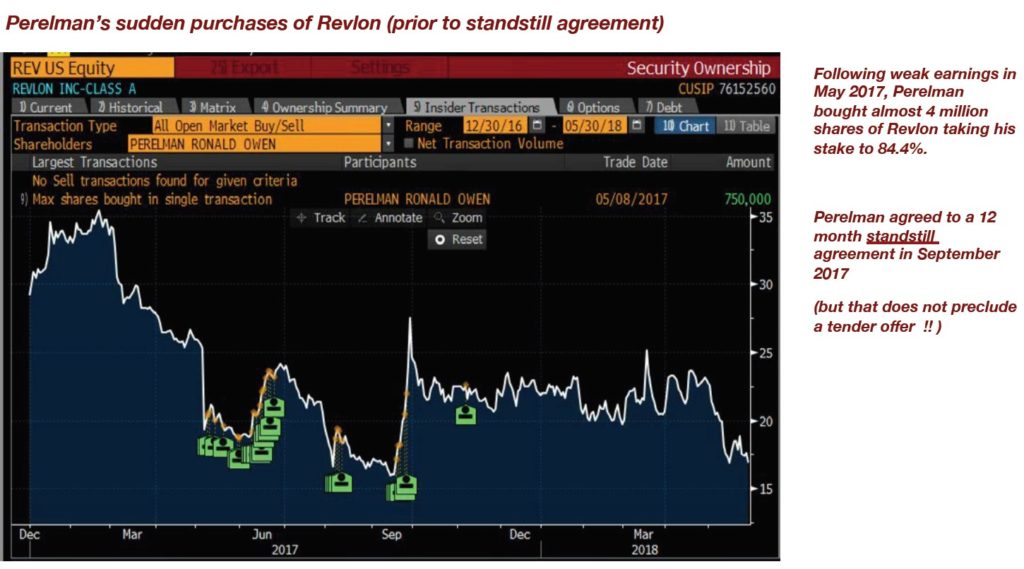Long Revlon (REV): Trap doors and black holes. Missed disclosure changes point to Revlon buyout.
Q1 hedge fund letters, conference, scoops etc, Also read Lear Capital: Financial Products You Should Avoid?
Much of the information in this report appears to have been entirely missed by the market. Only 5-10% of Revlon’s shares are in the public float. Only a single analyst covers the stock with only very perfunctory coverage. Revlon’s latest 10Q (May 2018) contains a subtle seven-word change from what was disclosed in the 10K in March. This disclosure now signals that Revlon is gearing up to conduct “asset transfers”, stripping bondholders of collateral so that Revlon can raise between $500 million and $1 billion to ramp up its turnaround program. Such a move is punishing to bondholders but will be sharply rewarding to shareholders because it demonstrates that billionaire Perelman is now entering the final stages of taking Revlon private.
J Crew had made use of a similar “trap door” feature last year to strip bondholders of collateral by shifting IP assets into unrestricted subsidiaries. But Revlon’s ability to move assets to the benefit of shareholders is far, far greater. According to Debtwire: “the trap door mechanics in Revlon are a bit different from J.Crew’s. Revlon’s trap door is more like a black hole.”
Perelman is unequivocally betting on a successful turnaround at Revlon. But he is also using the turnaround plan to acquire his new shares near multi year lows. In 2017, Perelman increased his stake in Revlon to 84.65%, paying up to $23.50. But many of his shares were acquired near multi year lows simply because his turnaround plan front-end-loads the expenses, pressuring the share price.
Right after the about-face on disclosure regarding asset transfers, Revlon immediately appointed Perelman’s daughter (Debra Perelman) as CEO.
Perelman already owns 84.65% of Revlon. In September 2017 he agreed to a standstill at the request of Mittleman Investment, the second largest shareholder. But it was later realized the standstill to which Perelman agreed does not preclude him from making a tender offer in the interim.
Perelman has repeatedly engaged in the same tactics to acquire past companies at bargain prices following very short-term quarterly weakness in financial results which were the predictable result of a planned restructuring. Because Perelman already owns 84.65% of Revlon, the price he pays for the remaining 15.35% stub will not have a meaningful effect on his overall average price. So he can certainly pay a significant premium. Mittleman claims that current fair value should be from $50 to $100. But actually, market comparables would put the price target closer to the lower end of $40-50 at present. In reality, Perelman will attempt to acquire the remaining 15.35% stub as cheaply as possible. He may be able to acquire the final shares at $32-36.
However, due to Revlon’s very low public float and high short interest, the share price could easily overshoot on any positive update. Short interest is over 2 million shares even though the tradable free float is just 5.2m shares (a 40% effective short interest).
Section I Long Revlon - Investment Overview
Revlon Background – much better than “Billions” .
Today I am looking at Revlon Inc. (REV) where an asset transfer and takeover play is emerging from billionaire Ronald Perelman. In September 2017, Forbes magazine named Perelman as one of the 100 Greatest Living Business Minds. Perelman has been involved in dozens of well orchestrated takeover plays over the past 40 years and is currently worth an estimated $13 billion. Perelman’s original hostile takeover of Revlon was very fittingly a focus of the 1980’s book “The Predator’s Ball”.
After being involved for more than 30 years, Perelman is about to make his final play to acquire all of Revlon. Because outside shareholders have largely misread recent financials and bondholder issues, Perelman is likely to be able to acquire the remainder of Revlon for somewhere in the range of $32-36 despite a fair value that is demonstrably much higher.
In general, I am starting to really like these billionaire plays. Unlike watching an episode of “Billions”, paying attention to the machinations of real corporate raiders can lead to some very profitable trades.
Last year my long trade on Carl Icahn's Hertz (HTZ) worked quite well. Following my report on Hertz, the shares quickly jumped 80% from $14.50 to $26.00 despite dire sell side warnings suggesting imminent bankruptcy. Prior to that, Icahn had previously been loading up on shares of Herbalife (HLF) at prices below $20, when the stock was widely being called “a zero”. Icahn only recently began selling when the share price exceeded $50.
Likewise, my thesis on Dillard’s has also been playing out, albeit a bit slower than expected. In 2008, David Einhorn had been caught on the wrong side of a painful “infinity squeeze” when the float at Volkswagen quickly disappeared. But in 2017 Einhorn could be found on the other side. Einhorn was the largest outside shareholder of heavily shorted Dillard’s (DDS) department store just as that company was buying back dangerous amounts of the float. Since my report, Dillard’s stock is now regaining multi year highs in the $80s. Surprisingly, Einhorn exited most of his position in the $60s.
MoxReports.com (Aug 2017) – Shares of Hertz Could Still Double From Here
MoxReports.com (Jul 2017) - Long Dillard’s on potential “infinity squeeze”
When, how and why. Summary of Perelman’s timeline to buy out Revlon
Background. Shares of Revlon have recently been hitting multi-year lows, based on two main factors. First, margins and overall financial results are under pressure due to spending increases required by Revlon’s 2017 turnaround plan. This turnaround plan was part of the integration of Elizabeth Arden which was acquired by Revlon in 2016. Second, shareholders have been spooked by Revlon’s plunging bond prices which appear to portend a high likelihood of bankruptcy. And now, billionaire Ron Perelman is set to aggressively capitalize on both of these market misreads of Revlon.
As the share price plunged during 2017, Perelman increased his stake in Revlon to 84.65%, paying up to $23.50 per share. Perelman has been heavily involved with Revlon since his 1986 hostile bid for Revlon. He is also the Chairman of Revlon. By late 2017, it was becoming apparent in the media that Perelman was actively looking to acquire the remainder of Revlon. Even when paying a substantial premium, Perelman could possibly acquire the remaining stub of Revlon in the $30’s, still below where it was trading in early 2017.
Perelman buyout becomes obvious. In August 2017, Revlon’s second largest shareholder (Mittleman Investment, 5.4% holder) demanded from Revlon’s board that Perelman enact a standstill agreement for five years. This would prevent Perelman from scooping up the entire company at artificially low prices prior to realizing the payoff from the turnaround program. Mittleman has owned Revlon since 2010 even when the share price was well into the $40s. Mittleman has stated that they expect the stock to trade to $50-100 when the benefits of restructuring kick in the next two years or so. So they are clearly unhappy about the idea of Perelman acquiring the company in the $30s, just as it is about to hit a sharp upward inflection point.
Perelman responded to Mittleman with a very token standstill agreement. Rather than five years, Perelman only agreed to a 12 month halt until September 2018. Furthermore, Mittleman later realized that the standstill agreement protects only against “short form merger” and NOT against a tender offer which could occur at any time (even before September).
Perelman knows what the market has missed. First, investors are misreading the financial performance of Revlon. Those expenses from the turnaround plan were set up to be very heavily front-end loaded. Expenses are just now dropping off sharply, just as the benefits are kicking in. Even small benefits like simple streamlining and end of severance payouts will quickly have a very significant impact on Revlon’s bottom line.
Second, the reason those bond prices are distressed is that bondholders are rightfully concerned that Perelman is going to conduct a “J Crew Style Asset Transfer” which would strip bondholders of their collateral and allow Perelman to fully finance the turnaround strategy and going private plan. Yes, this is very bad for bondholders. But it is actually very good for current shareholders who get bought out at a substantial premium from current levels. (Mittleman would not agree of course).
Rationale. Remember, Perelman already owns 84.65% of Revlon. Even if he acquires the remainder in the $30s it will not have a huge impact on his overall cost basis. His visible goal is simply to buy the stub and take the whole company private. If Perelman can acquire the remainder in the $30s, he stands to to reap $2-3 billion in profits by taking the company private at these artificial lows.
Precedents. In numerous past buyouts, Perelman scooped up dirt cheap shares just after unusually weak quarterly results and then watched his holdings soar by hundreds of percent within months. Multiple past examples are included in section IV of this report, including Perelman’s past “prescient” trades on Revlon.
New catalyst. Changes in Revlon’s latest 10Q (May 2018) are an abrupt about face from statements in the March 10K. These changes suddenly make clear the preparations for the asset transfers which Revlon had denied in March. No one seems to have noticed these changes. Almost immediately after changing that disclosure, Perelman appointed his daughter as CEO for all of Revlon. As a result, I see that timing on the asset transfers could be imminent. When that happens, the share price should spike ahead of Perelman’s very obvious buyout.
Technical overshoot. Low float. High short. Heavy leverage. Perelman and Mittleman now own over 47 million shares of Revlon, leaving only 5 million shares in the tradable float. Index funds own a further 2.5 million shares. Against this, over 2 million shares are currently sold short. Total value of tradable float is as low as $29 million. Tiny. Any small surge in buying activity could see Revlon overshoot into the $40s.
Article by Mox Reports
See the full PDF below.







